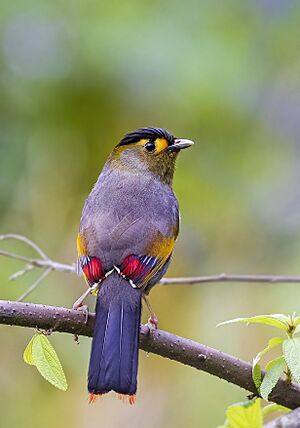Bugun liocichla facts for kids
Quick facts for kids Bugun liocichla |
|
|---|---|
 |
|
| Conservation status | |
| Scientific classification | |
| Genus: |
Liocichla
|
| Species: |
bugunorum
|
The Bugun liocichla (Liocichla bugunorum) is a rare and beautiful passerine bird. This means it's a type of bird that perches, like a robin or a sparrow. It belongs to the family Leiothrichidae. Scientists first saw this bird in 1995 in Arunachal Pradesh, India. They officially named it a new species in 2006.
It's very unusual that scientists described this bird without collecting a "type specimen." A type specimen is usually a dead animal kept for study. But there were so few Bugun liocichlas that scientists didn't want to risk harming any. This bird is considered an endangered species. It has a very small population and lives in a tiny area. Building projects in its home threaten its survival.
Contents
What Does the Bugun Liocichla Look Like?
The Bugun liocichla is a small bird, about 20 centimeters (8 inches) long. It has mostly olive-grey plumage (feathers) and a black cap on its head. Its face has bright orange-yellow patches near its eyes. Its wings are colorful with yellow, red, and white spots.
The tail is black, and the feathers under its tail are crimson red with red tips. Its feet are pink, and its beak is black near its face, fading to a pale white tip. Scientists caught another bird that looked duller. They think this was likely a female. The bird's song is described as clear and flute-like.
Where Do Bugun Liocichlas Live?
Scientists have only seen Bugun liocichlas at an altitude of 2,000 meters (about 6,500 feet). They live on hillsides covered with shrubs and small trees. One bird was seen at the edge of a thick forest. Their home is similar to where the Emei Shan liocichla lives.
In January, scientists saw small groups of these birds. In May, they saw pairs, which might be breeding. Experts believe there are only about 14 individual birds in total. It's possible that pairs claim and protect their own areas. So far, the Bugun liocichla is only known from one place. But scientists hope to find more populations in other parts of Arunachal Pradesh or nearby Bhutan.
Scientists are using computer models to find other suitable places where these birds might live. This helps them look for new populations.
How Was This Bird Discovered?
|
|||||||||||||||||||||||||||
| Relationship among liocichlas |
The Bugun liocichla was officially described in 2006. It was found in the Eaglenest Wildlife Sanctuary in Arunachal Pradesh, India. An astrophysicist named Ramana Athreya first spotted the bird in 1995. But then it wasn't seen again for ten years.
Athreya saw the birds again in January 2005. He waited to tell anyone until he was sure it was a new species. At first, it looked similar to the Emei Shan liocichla, a bird found only in China. But the Bugun liocichla was clearly different.
To fully describe the new species, scientists caught two birds using special nets called mist nets in May 2006. Because the species was so rare, they didn't collect a full "type specimen" (a preserved body). Instead, they used feathers caught in the net, photos, sound recordings, and notes. This was allowed by the rules for naming new animals.
Naming the Species
The scientific name, Liocichla bugunorum, and the common name, Bugun liocichla, come from the Bugun tribe. This tribe lives in the area where the bird was discovered. The bird was found in their community forests.
Scientists believe the Bugun liocichla is closely related to the Liocichla omeiensis. The tall Hengduan Mountains might have separated these two groups of birds over time. This separation could have led to them becoming different species.
Why Is the Bugun Liocichla Endangered?
The fact that such a striking bird with unique calls wasn't noticed until 1995 suggests it's not common. Only three breeding pairs are currently known. Because of its very small population, it is listed as critically endangered.
Even though the bird can live in forests that have been changed by humans, its tiny population is still at risk. There are plans to build a highway through what is thought to be its main home. This project could seriously threaten the Bugun liocichla's survival. Protecting its habitat is very important for this rare bird.


